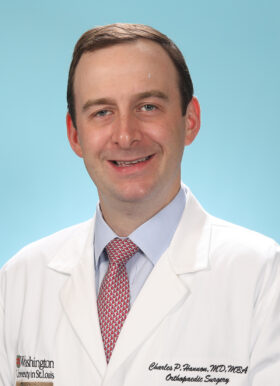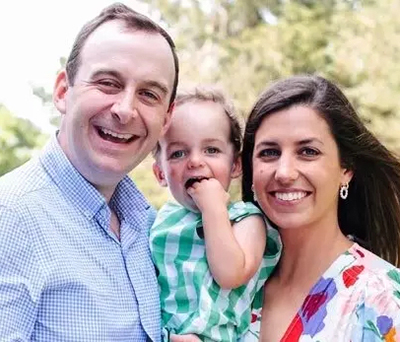Charles Hannon, MD, MBA

Charles Hannon, MD, MBA, is an orthopedic surgeon who specializes in hip and knee replacement surgery. He has a particular interest in rapid recovery protocols, partial knee replacement, robotic-assisted joint replacement, anterior hip replacement, and complex primary and revision hip and knee replacements.
For appointments, please call 314-514-3500.
What influenced you to choose your specialty?
I was born with a right club foot — a deformity of the bone structure in my foot. My mom asked the doctors, “If this was your son, who would you go to?” The answer was Dr. S. Jayakumar. He was known as Dr. Jay and he was my hero. I ended up having seven surgeries to correct my club foot, starting at a few weeks old. From the age of five, I wanted to be an orthopedic surgeon.
My family lived in New York City when I was born, and my parents soon took me to Wilmington, Delaware, to see Dr. Jay. He was a very soft-spoken, humble man. He would walk in the room, nod at my parents, look at me and ask, “Charles, how are you doing?” He was the only person who called me Charles, except for my mom when I was in trouble.
Dr. Jay would ask how school was going, how sports were going, how my friends were and how my grades were. I saw him four times a year and we had the same conversation until I was 21 years old. I had the opportunity and privilege to be able to shadow him when I was in college and medical school. It was amazing how he treated every single kid the exact same way. Those kids had the same smile that I did every time I went to see him. I said I want to be like that guy someday – and that is why I went into orthopedics.

What brought you to Washington University?
My interest has always been in academic medicine. I had the opportunity to train at Rush University Medical Center in Chicago and Mayo Clinic in Rochester, Minnesota. My wife is from Wisconsin, and we wanted to stay in the Midwest.
We were looking for an academic medical center whose mission integrated the three pillars of academic medicine:
- Provide outstanding clinical care
- Innovate the field through research
- Provide an education to the future leaders in orthopedics
No institution in the Midwest does a better job of integrating these pillars of medicine than Washington University. In addition, I knew after my interview that the faculty and staff made this a special place, and I wanted the opportunity to help further the mission here.
Which aspect of your practice is most interesting?
The most enjoyable part of my practice is the opportunity to get to know my patients and determine what treatments will help them return to the activities they love and live the life they want to live. The joy of my practice comes from working with my team to minimize the patient’s pain during this entire process in order to enhance recovery.
From a research standpoint, my major area of interest is pain management before, during and after surgery. How can we optimize pain control? Patients come to us and they are in pain, but the surgeries we do also cause pain. By using small scale randomized control trials, we are able to study how different medications impact patient care.
What new developments in your field are you most excited about?
Technology has become the hallmark of the care we provide in joint replacement. It’s amazing because there are so many new technologies. It is an exciting time for us at Washington University to study and compare these different technologies – what they can do, where they can provide value, how they allow us to track data and how they can improve the care we provide our patients.
In addition, we have revolutionized the way we treat pain before, during and after surgery. We now use a multimodal pain protocol with different types of pain medication – most of which are not opioids. Our goal is to reduce the pain and eliminate opioid consumption in order to get the patient up and walking the same day of surgery. Most of our patients are now able to go home the day after surgery and some are even able to go home the same day.
Where are you from?
I was born in New York City and grew up in Connecticut. I went to Villanova University for my undergraduate degree and medical school at Georgetown University. I came to the Midwest for residency training at Rush in Chicago, and did my fellowship at Mayo in Rochester, Minnesota.
Which particular award or achievement is most gratifying?
From a personal level, meeting my wife, Christina, is definitely the highlight of my life. Our son, John, is our pride and joy.
Professionally, during my second year of residency I was involved in a randomized control trial that studied opioid prescriptions after joint replacement that has really changed the care we provide our patients.
At that time, patients were typically given a prescription of 90-120 opioid pills after joint replacement surgery. A lot of our patients would come in after they had recovered and ask what they should do with all the extra pills. In light of the opioid epidemic, we did a very simple, but important randomized control trial, and for a group of patients reduced the prescribed number of opioid pills to 30. We found that for patients who were prescribed 90 pills, the median amount of leftover pills was 74. For those patients who received 30 pills, the median leftover pills was 14.
Our research paper had a huge impact on our clinical practice and many other practices. We actually received the best paper award at the American Association of Hip and Knee Surgeons in 2019. It obviously had a big influence on our patient care and changed the way we and other physicians prescribed pain medication.
What is the best advice you’ve received?
The best advice I’ve received was to treat others the way you want to be treated – The Golden Rule. That’s the approach I take with my patients, fellow staff members, and faculty.
If you weren’t a doctor, what would you like to be doing?
I’d be a doctor. There was nothing else I was going to do because of Dr. Jay.